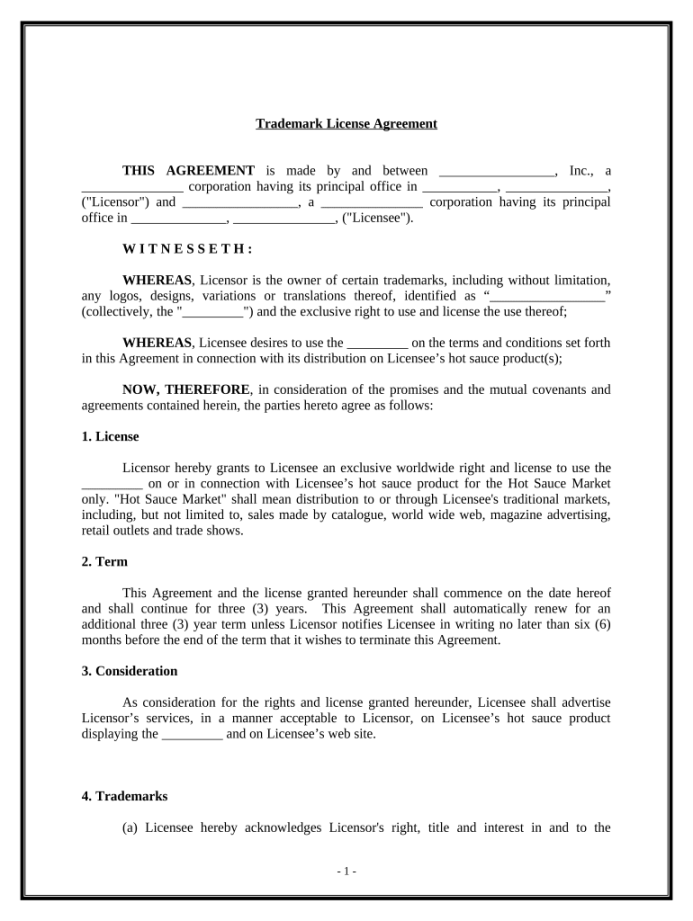Understanding the Brand Licensing Agreement Template
A brand licensing agreement is a legal document that outlines the terms and conditions under which a licensor grants permission to a licensee to use their brand or intellectual property for specific purposes. It is crucial for both parties to have a clear and comprehensive agreement to protect their interests and ensure a successful partnership.

Key Components of a Brand Licensing Agreement Template
1. Parties: Clearly identify the licensor and licensee, including their legal names, addresses, and contact information.
2. Grant of License: Specify the nature and scope of the license granted by the licensor. This includes the rights granted to the licensee, such as the right to use the brand name, logo, trademarks, or other intellectual property.
3. Term of License: Define the duration of the license agreement. This can be a fixed term or a perpetual license.
4. Royalty Payments: Outline the royalty payment structure, including the royalty rate, payment terms, and currency.
5. Territory: Specify the geographic areas where the licensee is authorized to use the brand or intellectual property.
6. Permitted Uses: Clearly define the permitted uses of the brand or intellectual property by the licensee. This includes the specific products or services that the licensee can offer under the brand.
7. Prohibited Uses: List any activities or uses that are prohibited by the licensee. This can include activities that may damage the brand’s reputation or dilute its value.
8. Quality Control: Establish quality control standards to ensure that the licensee’s products or services meet the licensor’s expectations.
9. Marketing and Promotion: Outline the marketing and promotional activities that the licensee is required to undertake to promote the brand.
10. Confidentiality: Require both parties to maintain the confidentiality of any confidential information disclosed during the course of the agreement.
11. Indemnification: Specify the indemnification obligations of each party. This can include indemnifying the other party for any losses or damages arising from the other party’s breach of the agreement.
12. Assignment and Transfer: Address the rights of each party to assign or transfer their rights and obligations under the agreement.
13. Dispute Resolution: Establish a dispute resolution mechanism, such as mediation or arbitration, to resolve any disagreements that may arise between the parties.
14. Governing Law: Specify the governing law that will apply to the agreement.
Design Elements for a Professional Brand Licensing Agreement Template
1. Clear and Concise Language: Use clear and concise language that is easy to understand for both legal and non-legal professionals. Avoid technical jargon or legal terms that may be unfamiliar to one or both parties.
2. Consistent Formatting: Maintain consistent formatting throughout the document, including font size, line spacing, and paragraph alignment. This will enhance readability and professionalism.
3. Headings and Subheadings: Use headings and subheadings to divide the document into sections and subsections. This will make it easier for readers to navigate and find the information they need.
4. Numbering and Bullet Points: Use numbering and bullet points to list items or steps within sections. This can help to improve clarity and organization.
5. White Space: Use white space effectively to create a visually appealing and easy-to-read document. Avoid overcrowding the page with text.
6. Professional Logo: Include a professional logo at the top of the document to identify the licensor and enhance the overall appearance.
7. Professional Stationery: Use professional stationery with your company’s letterhead and contact information. This will add a touch of legitimacy and professionalism.
Conclusion
A well-crafted brand licensing agreement template is essential for protecting the interests of both the licensor and licensee. By following the guidelines outlined in this article, you can create a professional and legally sound document that will serve as a solid foundation for your brand licensing partnership.


